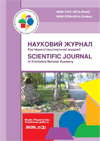UDC 37.012.85 PECULIARITIES OF MOTOR AND SPEECH RHYTHMIC PROCESSES FORMATION IN CHILDREN OF SENIOR PRESCHOOL AGE WITH STUTTERING BY MEANS OF LOGORHYTHMIC EXERCISES
DOI: https://doi.org/10.51706/2707-3076-2020-3-13
Abstract
The scientific article proves that the functional aspects of motor-speech development in senior preschool
children with stuttering are closely related to the basic morphofunctional provision of motor skills and speech, which
involves activating the cerebral cortex, improving blood supply to the brain, restoring motor and articulatory
innervation. By applying a multidisciplinary approach philosophical, psychophysiological, neurobiological,
psychological and linguistic aspects of the nature of rhythm were highlighted. Comparative indicators of the level of
motor and speech rhythm development were determined before and after performing logarithmic exercises.
Theoretical and methodological analysis of the problem of motor and speech rhythms development in
children of senior preschool age with stuttering confirmed the assumption about delayed rhythm development in
children of this nosological group. The need for a comprehensive study of this issue was the driving force for
carrying out the observational experiment, whose purpose was to study the peculiarities of the development of
motor and speech rhythms in older preschool children with stuttering. In the process of analyzing the comparative
characteristics of the levels of motor and verbal response in senior preschool children with stuttering, it was proved
that these two processes develop simultaneously and are interdependent. The retardation of one process leads to
the retardation of the other one, which affects the development of children's motor and verbal (speech) rhythm.
Comparative characteristics of the formation levels of motor and verbal rhythms in senior preschool
children with stuttering before and after correctional and developmental classes show that after performing
correctional and developmental exercises there are no children with zero and low levels of reproduction, while
medium and sufficient levels of motor reproduction and speech response prevail. This fact experimentally confirmed
that the selected correctional and developmental work, conducting of speech therapy and logorhythmic classes
aimed at the development of motor and verbal rhythms contributed to a significant improvement in the children’s
results


